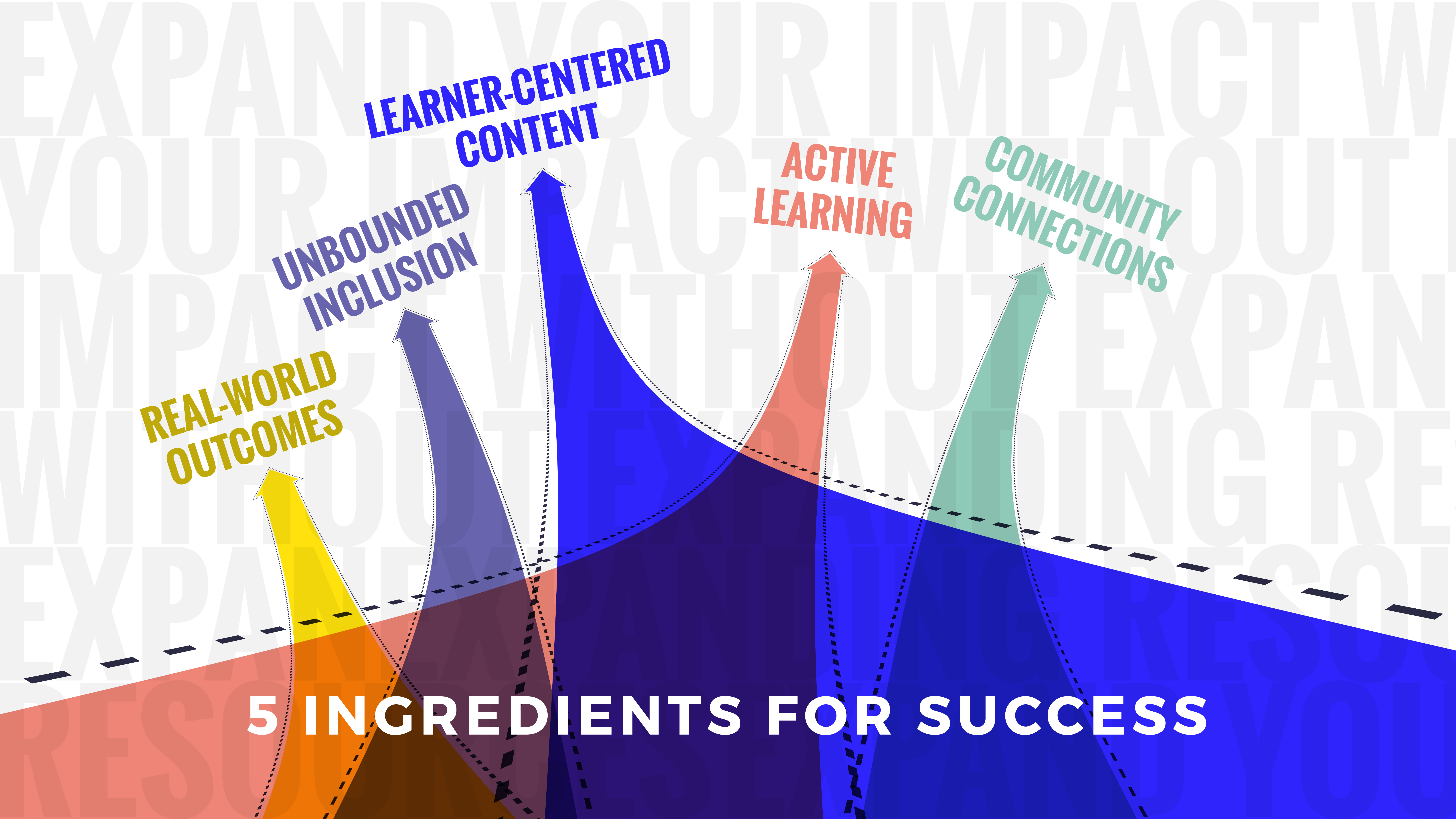At Extension Engine, we don’t build one-size-fits-all learning experiences. Instead we work alongside each organization we partner with to determine what they and their learners need, and then we deliver it in the best format for them. Thanks to our years of experience, we know how to create online learning that improves upon what our clients are already doing. Our goal is always to increase scale and engagement.
But what, you may ask, does that mean — and how do we do it?
High Engagement at Scale
When it comes to learning, you want your students to be really involved and invested in the knowledge you’re sharing with them. That’s what’s meant by “high engagement”: basically, it means you have a thoughtful, attentive student.
Prior to the current boom in digital learning, high engagement was only possible in small groups or — even better — in a one-on-one tutoring situation. That sort of setup is difficult to replicate in an online environment, particularly if your organization needs your learning environment to be useful and accessible to different-sized groups of people at different times. For example, you may have to offer a course to a hundred learners at once to preserve time or money. Meanwhile, you want to avoid high scale (that is, lots and lots of students) in the digital equivalent of a lecture hall, because huge online classes tend to have disengaged students.
What you need — and what EE can provide — is the technology and design to build an experience that offers both engagement and scale at once. Thanks to a host of options, it’s possible to increase engagement and scale without adding multiple complicated, expensive resources at the same time. That makes these online learning experiences a more sustainable option for businesses, nonprofits, and academic institutions alike. Think of Peloton, for a well-known example. Their workouts can be attended virtually by any number of people at once and yet retain high engagement because of how they’re structured and delivered.
5 Ingredients for Success
At EE, we believe there are five ingredients that will increase your chances of success when creating a digital learning experience for your learners. We aren’t prescriptive with these ingredients; the way we approach each one is dictated by the needs of the organization and its learners, and they can vary widely. But we consider each ingredient in the course of every project. They are:
- Learner-centered content
- Active learning
- Unbounded inclusion
- Community connections
- Real-world outcomes
Learner-centered content focuses on the learner’s needs, desires, and abilities. We consider the facets of content design, content types, learner responsiveness, assessment, and trusted sources. Our goal is to create well-designed, personalized learning content that allows the learner to map their own path through the material. This is what keeps a person engaged, interested, and active throughout their interactions with the course. We prioritize high production values, mixing media, text, and visuals to get the effect we want and using trusted brand names and effective instructors to present the material.
Active learning takes different active, applied, and integrative tools to get learners to set their own goals (intrinsic motivation) to achieve milestones, meet deadlines, and partake in peer review (extrinsic motivation). We design the content with an eye to the desired learner outcomes, focusing on highly interactive experiences — because that’s how people learn most effectively.
Unbounded inclusion refers to our choice to be supportive of all learners’ identities and experiences. Inclusive design is crucial for learners to feel a sense of belonging, which allows for deeper learning. For that reason, our approach to design is proactive and values driven. We ensure that the learning audience is represented in the content, bringing more lived identities into the mix and prioritizing universal design, an operations and service model, represented experiences, and viewpoint diversity.
When it comes to community connections, the goal is to leverage people (beyond just the official instructor of the course) to motivate and scale learning. Collaborations and team-based projects are a couple of methods to achieve this. Having peer cohorts and creating a wider community around your digital learning environment lead to increased engagement without increasing delivery costs and also result in more-personalized instruction. The social benefits of these things — collaborative learning, peer feedback, social learning, and a team teaching approach — can be significant.
Real-world outcomes are an important priority because you want your learners to be able to apply whatever they learn in your course to challenges in their lives, whether they’re professional, personal, or financial. To that end, it’s our goal to create competency-based learning experiences so that learners aren’t trapped working on problems or content they already know. In addition, you can do things such as connecting their learning to earning a certificate on LinkedIn so that there’s an immediate positive benefit to their career for knowing your content. There’s a focus on practical learning, impacted life outcomes, and connected experiences.
Conclusion
If you’ve been nodding along with all of these points but wondering how it would look in practice, check out some of EE’s case studies for past projects.
- We partnered with the University of Notre Dame to help them launch a master’s degree program in data science that preserved the “Notre Dame edge” for their online learners.
- The nonprofit Association of International Certified Professional Accountants turned to us when they wanted to scale in-person training to an online environment to prepare accounting professionals for a major exam.
- Financial-services-training leader Fitch Learning worked with us to get a rigorous classroom course online to equip its learners all over the world for their CFA® Program exam.
